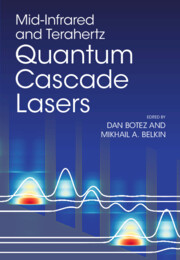Book contents
- Frontmatter
- Dedication
- Contents
- Preface
- Part I Bandstructure Engineering, Modeling and State-of-the-Art QCLs
- Part II Active Research Topics
- Part III Applications
- 12 QCL Applications in Scientific Research, Commercial, and Defense and Security Markets
- 13 QCL-based Gas Sensing with Photoacoustic Spectroscopy
- 14 Multiheterodyne Spectroscopic Sensing and Applications of Mid-Infrared and Terahertz Quantum Cascade Laser Combs
- 15 Self-Mixing in Quantum Cascade Lasers: Theory and Applications
- 16 Applications of Terahertz Quantum Cascade Lasers
- Index
13 - QCL-based Gas Sensing with Photoacoustic Spectroscopy
from Part III - Applications
Published online by Cambridge University Press: 25 August 2023
- Frontmatter
- Dedication
- Contents
- Preface
- Part I Bandstructure Engineering, Modeling and State-of-the-Art QCLs
- Part II Active Research Topics
- Part III Applications
- 12 QCL Applications in Scientific Research, Commercial, and Defense and Security Markets
- 13 QCL-based Gas Sensing with Photoacoustic Spectroscopy
- 14 Multiheterodyne Spectroscopic Sensing and Applications of Mid-Infrared and Terahertz Quantum Cascade Laser Combs
- 15 Self-Mixing in Quantum Cascade Lasers: Theory and Applications
- 16 Applications of Terahertz Quantum Cascade Lasers
- Index
Summary
Optical gas sensing is a promising alternative to analytical, electrochemical and semiconductor sensors that can offer fast responses times, minimal drift, high gas specificity, with zero cross-response to other gases. Quantum cascade lasers represent the optimal choice as mid-IR sources due to their high output power, compactness, narrow spectral linewidth and broad wavelength tunability. Among optical techniques, Quartz-Enhanced Photoacoustic Spectroscopy (QEPAS) has been demonstrated to be a leading-edge technology for real-world gas detection applications, thanks to its modularity, ruggedness, portability and real-time operation capability. QEPAS sensors typically achieve gas detection limits of few parts-per billion level. The basic principles of PAS are provided with a discussion on optoacoustic waves generation and detection. Quartz tuning forks physics is presented in detail, covering aspects like flexural modes resonance, including overtone, quality factor and microresonator tubes configuration. Finally, an overview of QCL-based QEPAS gas sensors for real-world applications, like environmental monitoring, breath sensing, leak detection and multi-gas detection is provided.
Keywords
- Type
- Chapter
- Information
- Mid-Infrared and Terahertz Quantum Cascade Lasers , pp. 410 - 442Publisher: Cambridge University PressPrint publication year: 2023

